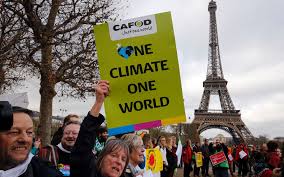
23 December 2015 – The Bulletin of the Atomic Scientists offers a pretty thorough run-down of the pros and cons of the Paris climate accords. William Sweet examines not only the political machinations behind the agreement but much of what the agreement entails and how it got there after 21 years of COP meetings:
“As for the tighter 1.5-degree standard, this is a complicated issue that the Paris accords fudge a bit. The difference between impacts expected from a 1.5-degree world and a 2-degree world are not trivial. The Greenland ice sheet, for example, is expected to melt in its entirely in the 2-degree scenario, while in a 1.5-degree world the odds of a complete melt are only 70 percent… But at the same time the scientific consensus is that it would be virtually impossible to meet the 1.5-degree goal because on top of the 0.8–0.9 degrees of warming that already has occurred, another half-degree is already in the pipeline, ‘hidden away in the oceans.”
In an additional audio recording of a teleconference briefing given to the Bulletin’s Science and Security Board and other leading scientists and policy makers, Sivan Kartha and Richard Somerville (both on the S & S Board) explain what was accomplished (and not accomplished).